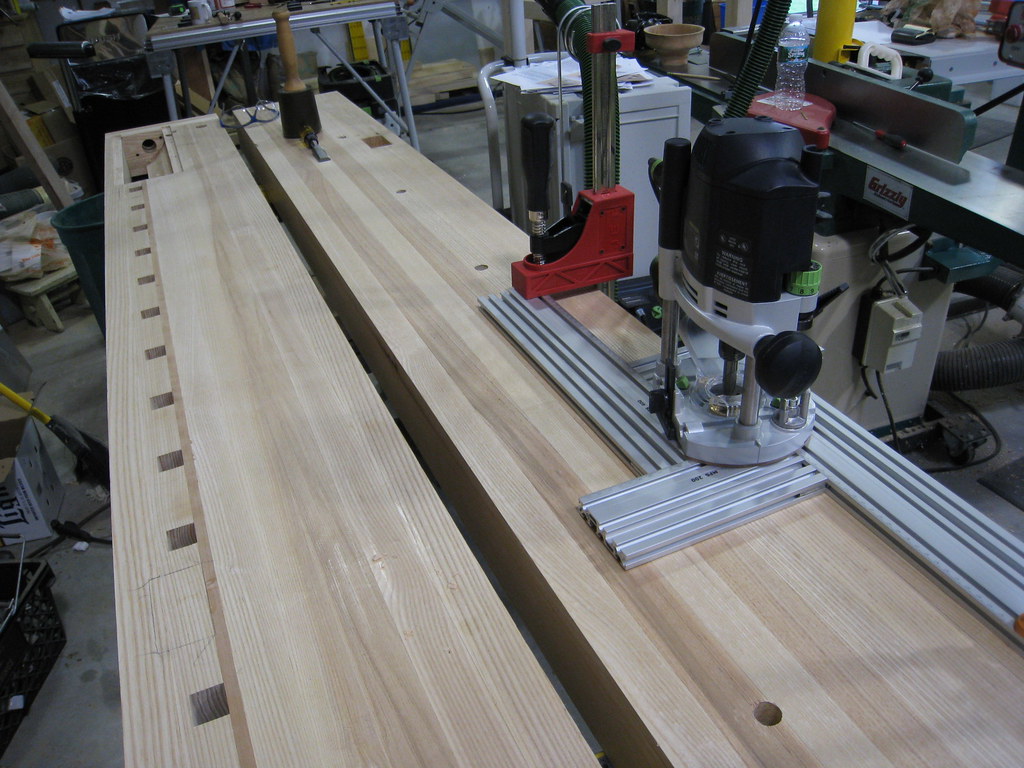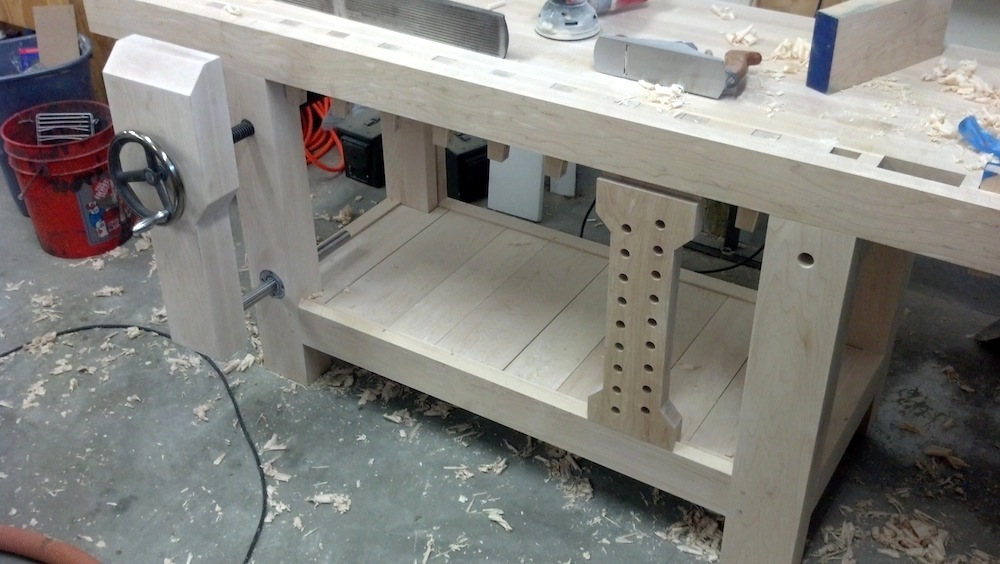
A leg vise moves via a single screw with a pinned sliding guide rail to maintain parallelism. The guide-rail pin rests against end-grain hard-maple pads that prevent compressing the softer alder leg of this bench. * The pin and sliding guide rail keep the jaw parallel for even clamping force.
How do you use a leg vise?
This leg vise has a very easy operation and utilizes a wedge on the floor and I mentioned earlier. As you can see from these photos, it can easily be used with one or two fingers, and that part impressed me. To use it, simple grab the piece you’re wanting to hold in the vise.
Does the shaft on a leg vice work?
Ok, so the shaft does make the vice super smooth and pin less, but for something so humble, today’s leg vice really did work a treat. I would certainly advice anyone who thinks that building with a ‘pinless’ leg vice is a touch on the expensive side, not to dismiss this vice in its original and simple form!
How does a woodworking vise work?
A woodworking vise, according to its dictionary definition, consists of two jaws for holding work and a mechanism, usually a screw device, that opens and closes those jaws.
What are the parts of a vise?
The vise’s constituent parts include a pair of iron jaws, while its other components—its slides, drive, screw, and handle—are usually steel. Like wooden face vises, the inner jaw is fixed, while the outer jaw is operated by turning the handle centered on the front of the tool.

How does a post vise work?
A blacksmith's post vise or "leg vise" is designed to be hammered on, unlike most bench-mounted machinist vises. The long leg transmits the energy from hammer blows all the way from the massive fixed jaw to the floor. Hot iron is secured in the vise and then shaped as needed by hammer blows.
Why do blacksmiths use leg vise?
What makes a leg vice special? One is that they are forgings, not cast iron or ductile iron. The second is the leg which provides support to the floor or from a sunken post. The leaf spring is a critical part of the vice, as it enables you to work quickly when securing your work.
How do you attach a leg vice?
3:357:00Installing a Leg Vise on a Workbench - 253 - YouTubeYouTubeStart of suggested clipEnd of suggested clipThe nut on from the backside. And then secure the nut with a couple wood screws. The leg vise thatMoreThe nut on from the backside. And then secure the nut with a couple wood screws. The leg vise that we are installing is modeled after the leg vise that I use in my shop.
How do you mount a blacksmith leg vice?
1:5417:54The best way to mount a leg vise. - YouTubeYouTubeStart of suggested clipEnd of suggested clipBecause when people are pulling them out they just boom knock that out take the vise. And leave theMoreBecause when people are pulling them out they just boom knock that out take the vise. And leave the mounting bracket which is too bad because it's a lot of work to make.
How do you identify a post vise?
2:384:57Identifying blacksmith leg vise material, wrought iron, steel, etc - YouTubeYouTubeStart of suggested clipEnd of suggested clipThe bottom left is the cast iron swage block and the bottom right is the high carbon steel.MoreThe bottom left is the cast iron swage block and the bottom right is the high carbon steel.
How do you build a leg vise?
3:554:59Build a Workbench Leg Vise - YouTubeYouTubeStart of suggested clipEnd of suggested clipI cut one half down to make it a smaller 12 inch wedge for work pieces up to three inch wide. I thenMoreI cut one half down to make it a smaller 12 inch wedge for work pieces up to three inch wide. I then use the wedge to mark off the corresponding. Piece that I needed to remove on the chop.
Which material is used for making a leg vise?
It is sometimes made of cast steel or malleable cast iron, but most are made of cast iron.
How does a wagon vise work?
8:149:07$24 Wagon Vise - YouTubeYouTubeStart of suggested clipEnd of suggested clipReally really well the main point of a wagon vise is to be able to clamp laterally. On the ends ofMoreReally really well the main point of a wagon vise is to be able to clamp laterally. On the ends of the boards.
How do you use end vise?
9:4514:19Shop time: End Vise. - YouTubeYouTubeStart of suggested clipEnd of suggested clipAnd run into the Vice here. So it's very handy for just small little chamfers on the corners of workMoreAnd run into the Vice here. So it's very handy for just small little chamfers on the corners of work pieces. So I'll put a chamfer on here to prevent it from blowing out in just a second.
How do you use a blacksmith vice?
0:1010:04Vises for the blacksmith shop - tool of the day - YouTubeYouTubeStart of suggested clipEnd of suggested clipBut the jaw can move and wiggle a little bit. Because all of the weight. From working on the theMoreBut the jaw can move and wiggle a little bit. Because all of the weight. From working on the the jaws up here is transferred down through that portion of the vise. To.
What is a leg vice made of?
Leg Vices were traditionally made from Wrought Iron and are still Forged in steel.
What is Pipe vice?
Definition of pipe vise : a vise shaped to hold pipe for threading, cutting, or reaming.
What is machine vice?
A machine vise — a mechanical device designed to hold workpieces still during machining operations — can function as manual components or as a machining device. Many typical manufacturing facilities use machining vises for applications that have tight tolerances and require high precision.
What is hand vise?
Definition of hand vise : a small clamp or vise on a handle designed for holding small objects while they are being worked usually by hand.
Step 1: Materials You'll Need
I did not have a thick enough board so I cut a board in half and glued the two pieces together after making the surface of both pieces flat and clean.
Step 2: Make the Slot for the Supporting Leg
Cut a slot at one end of the board to fit the supporting leg in to it.
Step 5: Place the Leading Screw
Drill a hole that will go through the vise and the table leg, big enough to let the leading screw pass through.
What to use to keep leg vise from racking?
I also cut a wedge out of some pine on the bandsaw. This will be used on the floor to help keep the leg vise from racking when you clamp something at the top. I’ll explain more at the end of the post about how it functions.
How to use a wedge vise?
To use it, simple grab the piece you’re wanting to hold in the vise. Close the vise until it makes a little bit of contact at the top. Then, use your foot to kick in the wedge until it engages with the vise at the bottom. Then, turn the handle of the vise about another 1/8 turn and it will be very solid. I can’t believe that’s all it takes to hold it so well, you can’t even get the piece to move when pounding on it!
Can you use a leg vise with one finger?
This leg vise has a very easy operation and utilizes a wedge on the floor and I mentioned earlier. As you can see from these photos, it can easily be used with one or two fingers, and that part impressed me.
What are the parts of a vise?
The vise’s constituent parts include a pair of iron jaws, while its other components—its slides, drive, screw, and handle—are usually steel. Like wooden face vises, the inner jaw is fixed, while the outer jaw is operated by turning the handle centered on the front of the tool. Clockwise motion will tighten the screw mechanism, ...
What is a vise in woodworking?
A woodworking vise, according to its dictionary definition, consists of two jaws for holding work and a mechanism, usually a screw device, that opens and closes those jaws. That’s a rather broad definition, but then vises are a rather diverse lot. For convenience, vises are loosely categorized by the position on the woodworking bench they usually ...
What is the end vise on a bench?
Built into the end of a bench (almost always the right-hand end), the end or tail vise, as it is also called, can be used to clamp workpieces to the bench between its jaws. The flush-mounted end vise uses the benchtop as the inside jaw, and the bench screw drives the movable jaw tight against it.
What is the clockwise motion on a bench?
These vises are usually located over or near a leg (to avoid putting unnecessary force on the benchtop ) and are fastened with lag screws or carriage bolts.
Where are the vises on a woodworking bench?
Woodworker’s vises are designed to be attached to the underside of the front of a woodworking bench. The vise’s constituent parts include a pair ...
How wide is a woodworker's vise?
Woodworker’s vises come in almost any size, with jaws ranging from six inches wide to ten inches or more, with a maximum opening capacity ranging from roughly four to as many as fifteen or more inches. The size you need depends upon the size of the stock you will be likely to use for most of your projects. Advertisement.
What is a dog hole in a vise?
It is distinguished from other vises in that a rectangular hole is cut into its top, and that hole is aligned with a series of other holes along the front of the benchtop. A workpiece to be shaped or cut is set along the front of the bench, flush to a bench dog set into the “dog-hole” in the vise.
Can a metal vise be retrofitted?
And it also seems as if you need to plan the whoile workbench around a leg vise. A metal vise, on the other hand, can be easily retrofitted or incorparated on most any workbench.
Does a vise work better on heavy chisel work?
It also holds work better for heavy chisel work, slip a block under the leg, makes for a much more solid hold then the regular vise. Tedstor.